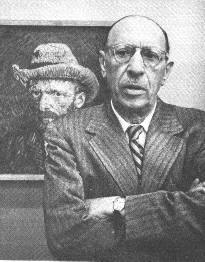Introduction
(born Lomonosov, 17 June 1882; died New York, 6 April 1971).
Russian composer, later of French (1934) and American (1945) nationality.
The son of a leading bass at the Mariinsky Theatre in St. Petersburg,
he studied with Rimsky-Korsakov (1902-8), who was an influence on his early
music, though so were Tchaikovsky, Borodin, Glazunov and (from 1907-8)
Debussy and Dukas. This colourful mixture of sources lies behind The
Firebird (1910), commissioned by Dyagilev for his Ballets Russes. Stravinsky
went with the company to Paris in 1910 and spent much of his time in France
from then onwards, continuing his association with Dyagilev in Petrushka
(1911) and The Rite of Spring (1913).
These scores show an extraordinary development. Both use folktunes,
but not in any symphonic manner: Stravinsky's forms are additive rather
than symphonic, created from placing blocks of material together without
disguising the joins. The binding energy is much more rhythmic than harmonic,
and the driving pulsations of The Rite marked a crucial change in
the nature of Western music. Stravinsky, however, left it to others to
use that change in the most obvious manner. He himself, after completing
his Chinese opera The Nightingale, turned aside from large resources
to concentrate on chamber forces and the piano.
Partly this was a result of World War I, which disrupted the activities
of the Ballets Russes and caused Stravinsky to seek refuge in Switzerland.
He was not to return to Russia until 1962, though his works of 1914-18
are almost exclusively concerned with Russian folk tales and songs: they
include the choral ballet Les noces ('The Wedding'), the smaller
sung and danced fable Renard, a short play doubly formalized with
spoken narration and instrumental music (The Soldier's Tale) and
several groups of songs. In The Wedding, where block form is geared
to highly mechanical rhythm to give an objective ceremonial effect, it
took him some while to find an appropriately objective instrumentation;
he eventually set it with pianos and percussion. Meanwhile, for the revived
Ballets Russes, he produced a startling transformation of 18th-century
Italian music (ascribed to Pergolesi) in Pulcinella (1920), which
opened the way to a long period of 'neo-classicism', or re-exploring past
forms, styles and gestures with the irony of nondevelopmental material
being placed in developmental moulds. The Symphonies of Wind Instruments,
an apotheosis of the wartime 'Russian' style, was thus followed by the
short number-opera Mavra, the Octet for wind, and three works he
wrote to help him earn his living as a pianist: the Piano Concerto, the
Sonata and the Serenade in A.
During this period of the early 1920s he avoided string instruments
because of their expressive nuances, preferring the clear articulation
of wind, percussion, piano and even pianola. But he returned to the full
orchestra to achieve the starkly presented Handel-Verdi imagery of the
opera-oratorio Oedipus rex, and then wrote for strings alone in
Apollon musagete (1928), the last of his works to be presented by
Dyagilev. All this while he was living in France, and Apollon, with
its Lullian echoes, suggests an identification with French classicism which
also marks the Duo concertant for violin and piano and the stage
work on which he collaborated with Gide: Perséphone, a classical
rite of spring. However, his Russianness remained deep. He orchestrated
pieces by Tchaikovsky, now established as his chosen ancestor, to make
the ballet Le baiser de la fée, and in 1926 he rejoined the
Orthodox Church. The Symphony of Psalms was the first major work in which
his ritual music engaged with the Christian tradition.
The other important works of the 1930s, apart from Persephone,
are all instrumental, and include the Violin Concerto, the Concerto for
two pianos, the post-Brandenburg 'Dumbarton Oaks' Concerto and the Symphony
in C, which disrupts diatonic normality on its home ground. It was during
the composition of this work, in 1939, that Stravinsky moved to the USA,
followed by Vera Sudeikina, whom he had loved since 1921 and who was to
be his second wife (his first wife and his mother had both died earlier
the same year). In 1940 they settled in Hollywood, which was henceforth
their home. Various film projects ensued, though all foundered, perhaps
inevitably: the Hollywood cinema of the period demanded grand continuity;
Stravinsky's patterned discontinuities were much better suited to dancing.
He had a more suitable collaborator in Balanchine, with whom he had worked
since Apollon, and for whom in America he composed Orpheus
and Agon. Meanwhile music intended for films went into orchestral
pieces, including the Symphony in Three Movements (1945).
The later 1940s were devoted to The Rake's Progress, a parable
using the conventions of Mozart's mature comedies and composed to a libretto
by Auden and Kallman. Early in its composition, in 1948, Stravinsky met
Robert Craft, who soon became a member of his household and whose enthusiasm
for Schönberg and Webern (as well as Stravinsky) probably helped make
possible the gradual achievement of a highly personal serial style after
The Rake. The process was completed in 1953 during the composition
of the brilliant, tightly pattemed Agon, though most of the serial
works are religious or commemorative, being sacred cantatas (Canticum
sacrum, Threni, Requiem Canticles) or elegies (In
memoriam Dylan Thomas, Elegy for J.F.K.). All these were written
after Stravinsky's 70th birthday, and he continued to compose into his
mid-80s, also conducting concerts and making many gramophone records of
his music. During this period, too, he and Craft published several volumes
of conversations.
Extracted with permission from
The Grove Concise Dictionary of Music
edited by Stanley Sadie
© Macmillan Press Ltd., London. |
Detailed Information about
-
The Making of a Love Triangle : Stravinsky's Ballet Petrushka
from the Classical Music Pages Quarterly
-
Picture Gallery
-
List of Works
-
Bibliography
can be found on the internet on:
Classical Music Pages:  |
This project was created by Matt Boynick.
© 1 February 1996
Last Revision - 25 August 1999
|

